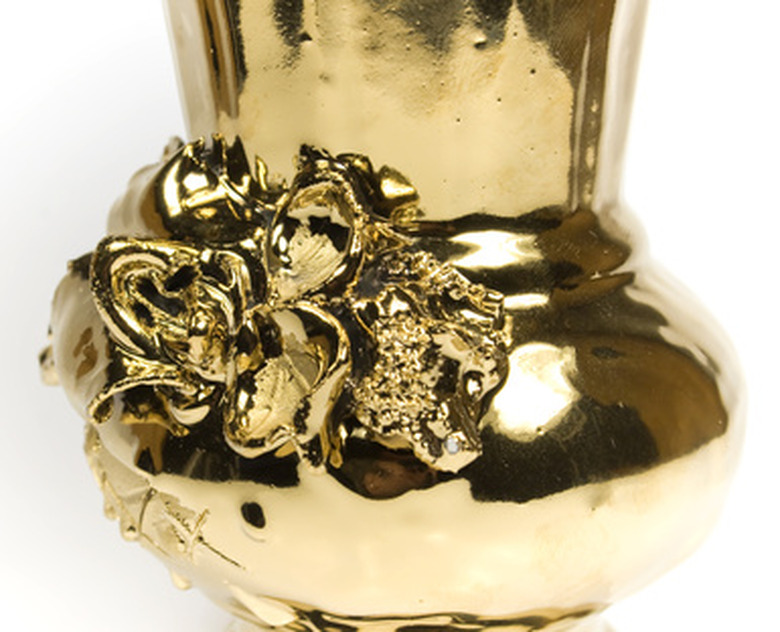Chemicals Used In Gold Plating
Gold plating is the process of coating a layer of gold over top of another metal. Many jewelers use gold plating for adding gold coloring to cheaper metals to create low-cost jewelry. Gold plating is also commonly used in electronics on top of nickel elements to prevent circuit boards from corroding. Gold plating materials include a metal object to plate, metal salts, potassium gold cyanide and an electrical current.
Electroplating Facts
Electroplating Facts
Electroplating uses an electrical current to chemically bond metals by partially melting them. Electroplated coatings are approximately 0.0002 inches thick. Over time, electroplated layers can rub off with wear but will not flake off or split away due to the chemical bond between the metals.
Multiple layers of metals can be applied with electroplating. Because gold bonds to some metals, such as silver and titanium, better than others like copper or nickel, different metal bonds will result in longer-lasting gold plates. The base layer also thickens the layer for more base protection. Sometimes small amounts of nickel or cobalt are added to the gold itself, hardening it. Tarnished or worn gold-plated objects can be replated to enhance their luster and performance.
Gold Plating Chemicals and Formula
Gold Plating Chemicals and Formula
Essential gold plating materials include surface-preparation products such as solvents or a non-acid ultrasonic bath and metal salts. Before beginning the electroplating formula, the piece of metal to be plated must be extremely clean. Surface preparation may include a variety of methods such as sanding, polishing, sandblasting and tumbling, and then dipping the metal object in a bath of hydrochloric acid, also called muriatic acid.
Once clean, the object is placed in a bath of metal salts. An electric current is placed through this bath and is directed at the object. The current helps to dissolve the metal molecules and deposit them onto the object in the bath. The longer items are left in the bath with the current, the thicker the plating level will be.
Metal Salts
Metal Salts
The metal salts used in gold plating will depend on what metals will be used in the layering process. For example, if the base coat will be nickel, then nickel salts will be used first, followed by gold salts. Metal salts are created through a neutralization reaction when an acid and base are combined. The positively charged ions of a metal combine with the acid or a nonmetal. These salts are then mixed with water to create the bath the item to be plated will sit in.
Agua Regia
Agua Regia
Aqua regia is a mixture of nitric acid and hydrochloric acid at a 1:3 ratio. Adding gold to aqua regia dissolves it, forming gold chloride and toxic fumes as a byproduct. Depending on the purity of the gold, this solution may contain other solid metals like copper and silver that need to be filtered out. After filtering, gold is precipitated out of the solution using sodium metabisulfite.
This gold is once again dissolved in the aqua regia to form a more pure gold-chloride solution. Red-gold chloride crystals are then extracted from the gold chloride through high-temperature evaporation. The final solution used in gold plating is an alkaline mixture of gold chloride and potassium ferrocyanide.
Potassium Gold Cyanide
Potassium Gold Cyanide
The most important chemical in many gold plating processes is potassium gold cyanide. Using potassium gold cyanide gives a more pure coverage compared to other methods which use aqua regia. The potassium gold cyanide mother liquid is made in a batch process by placing potassium cyanide and gold chloride in a bath of heated electrolyzed water called anolyte.
Potassium gold cyanide is a highly toxic chemical and should only be used under the supervision of an experienced person. Poisoning can result from ingestion, inhalation, skin exposure or eye contact. Potassium gold cyanide poisoning affects a person's ability to use oxygen. The side effects from poisoning generally present rapidly. Ingesting less than a teaspoon can result in death.
References
- Thermo Fisher Scientific: How Gold Plating Is Done, Step by Step
- Sharretts Plating Company: How Gold Electroplating Is Done
- Gold Bulletin: Understanding Gold Plating
- Sharretts Plating Company: The Use of Gold Plating in Electronics and Electrical Components
- Centers for Disease Control and Prevention: Potassium Cyanide: Systemic Agent
- Gold Plating Services: Steps for Creating a Gold Plating Emulsion
Cite This Article
MLA
Jerrett, Adrianne. "Chemicals Used In Gold Plating" sciencing.com, https://www.sciencing.com/chemicals-used-gold-plating-7245369/. 30 September 2021.
APA
Jerrett, Adrianne. (2021, September 30). Chemicals Used In Gold Plating. sciencing.com. Retrieved from https://www.sciencing.com/chemicals-used-gold-plating-7245369/
Chicago
Jerrett, Adrianne. Chemicals Used In Gold Plating last modified March 24, 2022. https://www.sciencing.com/chemicals-used-gold-plating-7245369/
